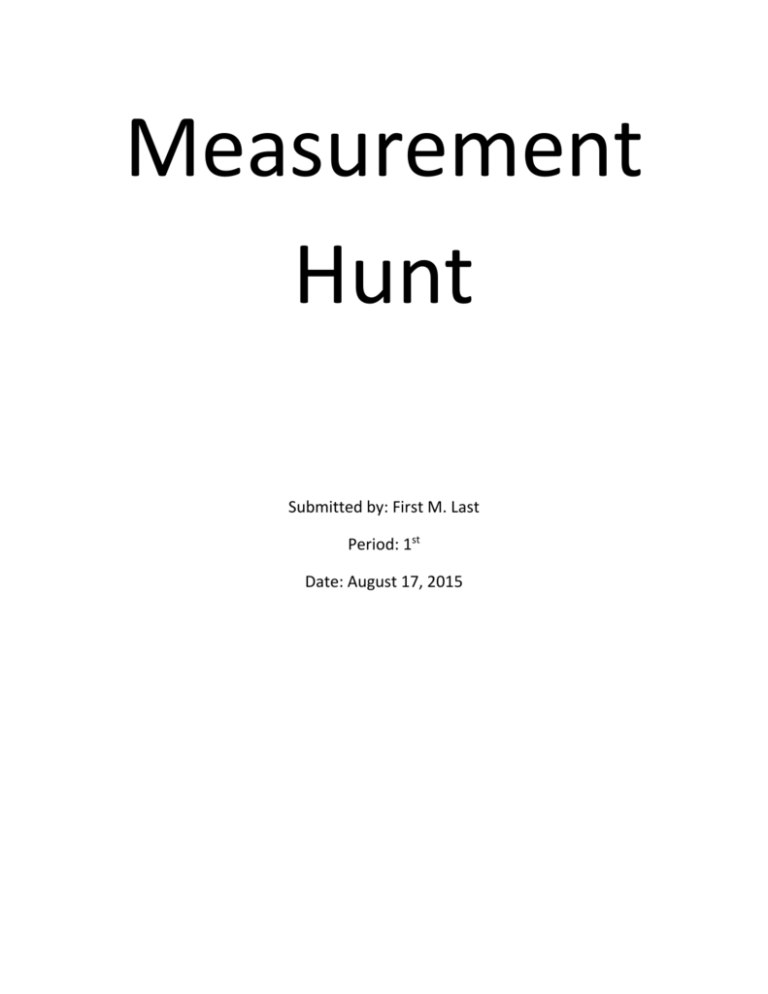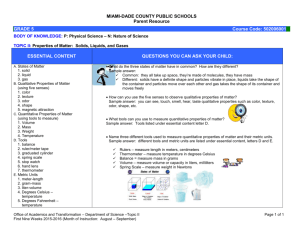File
advertisement

Measurement Hunt Submitted by: First M. Last Period: 1st Date: August 17, 2015 Table of Contents Problem……………………………………………………………………………………………………….1 Hypothesis…………………………………………………………………………………………………..1 Purpose/Theory…………………………………………………………………………………………..1 Research Words………………………………………………………………………………………….2 Materials……………………………………………………………………………………………………..3 Procedure……………………………………………………………………………………………………4 Observations……………………………………………………………………………………………….5 Conclusion…………………………………………………………………………………………………..6 Problem: How many different observations and measurements can be taken of five different common classroom objects? Hypothesis: It is hypothesized that at least five quantitative and five qualitative measurements can be made for all five different objects, and the quantitative measurements can be converted between English and Metric measurements. Purpose/Theory: The purpose of this lab exercise is to determine and learn the different methods of quantitative and qualitative data analysis of solid and liquid objects and to learn how to use conversion of those measurements both within the existing scale and between English and Metric measurements. Research: Data analysis is the practice of getting data, and then going over it or converting it to determine the results of an effort, like experimentation. This analysis is then used to determine a conclusion, as well as to communicate information about the effort a person did. Data are the descriptions taken from the exercise, which are the spoken or written representation or account of a person, object, or event (Dictionary.com, 2015). The English system of measurement is a system of weights and measures such as the inch, yard, quart, ounce and pound that evolved over time and was used throughout most of the world. The system was developed out of necessity and there was no major standard in the measurements other than the existing use of a standard of measurement already established by others and by opinion. For instance, the Romans liked the number 12, so they produced the 12 inches to produce a foot base. Very few countries still use this method of measurement, the primary country still using this method of measurement is the United States, who has not converted to the traditional metric method of measurement due to the cost of conversion of the standards that make up the English system (study.com, 2015). The inch is a unit of linear measure equal to one twelfth of a foot (2.54 cm) (Dictionary.com, 2015). The metric system (or Scientifique International – SI) unit of measurement is the primary system of measurement in most other countries, while the United States uses both English and Metric systems. The metric system is based on 10’s. The metric system uses units such as meter, liter, and gram to measure length, liquid volume, and mass. The “power of ten” measurement indicates that units within the system get larger or smaller by a power of 10. This means that a meter is 100 times larger than a centimeter, and a kilogram is 1,000 times heavier than a gram (Monterey Institute, 2015). The basic measurement of length in the metric system is a meter, which is equal to 100 centimeters or approximately 39.37 inches (Dictionary.com, 2015). Common Measurements in Customary and Metric Systems Length 1 centimeter is a little less than half an inch. 1.6 kilometers is about 1 mile. 1 meter is about 3 inches longer than 1 yard. Mass 1 kilogram is a little more than 2 pounds. 28 grams is about the same as 1 ounce. Volume 1 liter is a little more than 1 quart. 4 liters is a little more than 1 gallon. (Monterey Institute, 2015) Prefixes in the Metric System kilo- hecto- 1,000 100 timeslarger t timeslarger t han base unit han base unit (Monterey Institute, 2015) deka- met er gra m liter deci- centi- milli- 10 timeslarger t han base unit base units 10 timessmaller t han base unit 100 timessmaller t han base unit 1,000 timessmaller t han base unit The names of metric units are formed by adding a prefix to the basic unit of measurement. To tell how large or small a unit is, look at the prefix. To tell whether the unit is measuring length, mass, or volume, look at the base (Monterey Institute, 2015). A qualitative measurement is a measurement that relates or measures the quality such as color, texture or shape of an object. A quantitative measurement is numerical and measured using measuring instruments such as length, width, height, mass, temperature, volume, etc. (dictionary.com, 2015). Measurement instruments include items such as rulers, scales, water displacement, thermometers, and other items marked off in pre-established measurements. Qualitative measurement includes using the five senses: sight, sound, touch, taste, and smell. The data taken from these measurements are then analyzed and placed into forms of presentation such as tables and graphs to see if the hypothesis is answered or rejected, to draw a conclusion from the data and evidence collected in the experiment. Materials: Equipment Chemicals Biological Ruler Water Item 4 Notebook Item 2 Item 5 250 mL Beaker (1) 100 mL graduated cylinder (1) Item 1 Item 3 Forceps Scale Thermometer Procedure: 1. Line up measuring implements including ruler and scale. Separate the class into groups of two. Challenge the class to find 5 things in the classroom to measure, and challenge them measure each item at least 5 times quantitatively, and 3 times qualitatively. 2. After 20 minutes, end the measuring efforts, after students have located and measured their items. 3. Graph quantitative data to compare, and place qualitative data into a table. 4. Convert each number from the quantitative measures into 2 smaller and 2 larger levels, as well as convert to English measurement. 5. Each team should present their findings to the class and compare the accuracy of their measurements particularly with other students who measured similar items. Observations It was observed that there was not enough time to fully observe and collect the maximum amount of quantitative and qualitative data on multiple objects. The easiest observations to take for the majority of the items selected were weight and the overall area (length, width and height) water displacement of smaller objects, or other quantitative data. The qualitative data was more difficult to determine because what one person sees is not necessarily what the next person sees, particularly with color. The majority of the quantitative measurements were accurate compared to the qualitative measurements, particularly in understanding the dimensions of the object precisely. As an extra measure, the same measurements were taken using the English system and then compared to the conversions and accuracy. Metric had a slightly more accurate report than the English measurements both before conversion and after. The quantitative measurements took longer to determine than the qualitative, as the measurements had to be precise. L/W/H Weight (g) Color Shape Smell/Touch (cm) Item 1 21/13/11 19 Red Square Woody Item 2 None 16 Clear Liquid Sharp/Cool Item 3 11/2/2 3 Silver Long/Narrow Metallic/Cold Item 4 33/1/33 42 Green Roundish Woody/Smooth Item 5 28.2/2/2.4 27 Pink Roundish No smell/Smoothish Deg. F Measurements vs. Converted 80 70 60 oF 50 oF 40 Converted oF 30 20 10 0 Item 1 Item 2 Item 3 Item 4 Item 5 Deg C Measurements vs. Converted 25 20 15 oC oC 10 Converted oC 5 0 Item 1 Item 2 Item 3 Item 4 Item 5 (can add diagrams too) The data collected was placed into tables and the final result was charted as numerous items of data were used to produce the measurements. Item 1 was a wooden block, Item 2 was vinegar colored with food coloring, Item 3 was a lab instrument brought in called an inoculation loop, Item 4 was a plant, and Item 5 was my Index finger. Identifiers could also be used from the materials list as it was separated into Equipment, Chemical and Biological. There were many more identifiers for each object, but the ones selected for the table were those that were common to all five items selected. Two other teams in the class selected the similar or same items, the inoculation loop and the index finger being the differing items, while the others would show up randomly in other team’s selections. There was also a noticeable difference in the conversion numbers versus the actual measurements in particularly the temperatures as indicated in the graphed data. The converted numbers were generally off by between two tenths of a unit and four tenths of a unit between Fahrenheit and Celsius. This may have been caused by a variation of temperature in the room between measurements, an error in calculations, or an actual variance in the mathematical conversion versus the physical conversion. Conclusion: Upon conducting the experiment and analyzing the data it can be concluded that all five items that were selected by my team were identified primarily through the quantitative data and then the qualitative data, though both seemed to be needed to truly identify the items selected properly. The quantitative data could be converted in both larger and smaller directions as well as between English and Metric measurements. It was noted that there was a slight discrepancy in the calculated measurements versus the physical measurements particularly in temperature, where the physical measurement was different from the calculated conversion measurement by a few tenths of a point. This data supports the hypothesis as stated and therefore the hypothesis is accepted. Further experimentation could include more items, and determining if there is really a major discrepancy between all other English to Metric measurements and which is more accurate. Bibliography/Works Cited Dictionary.com. 2015. General definitions. http://dictionary.reference.com/ Monterey Institute. 2015. “The Metric System of Measurement” http://www.montereyinstitute.org/courses/DevelopmentalMath/COURSE_ TEXT_RESOURCE/U06_L2_T1_text_final.html Study.com. 2015. “English System Of Measurement: Definition, History, Advantages & Disadvantages”. http://study.com/academy/lesson/englishsystem-of-measurement-definition-history-advantages-disadvantages.html







